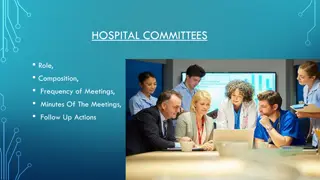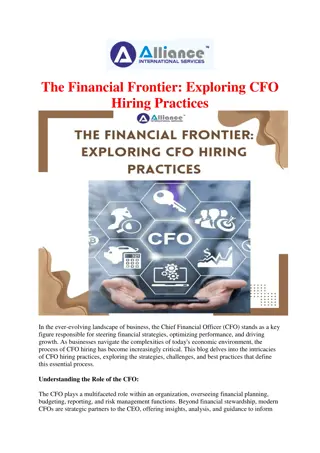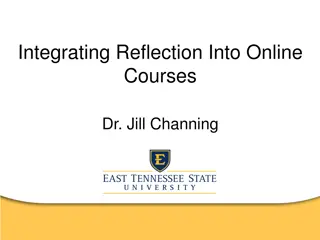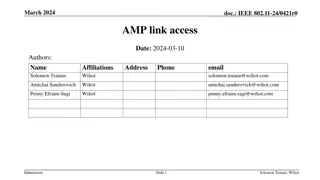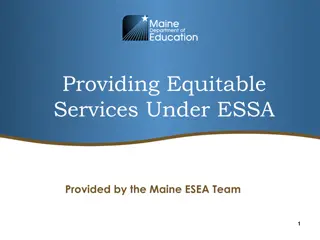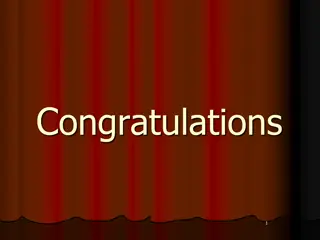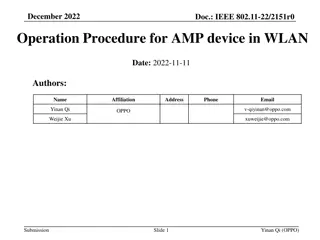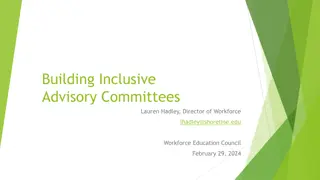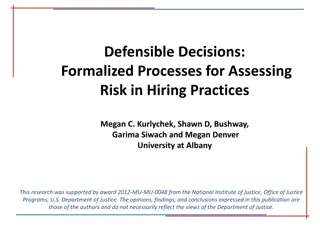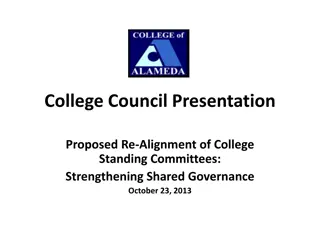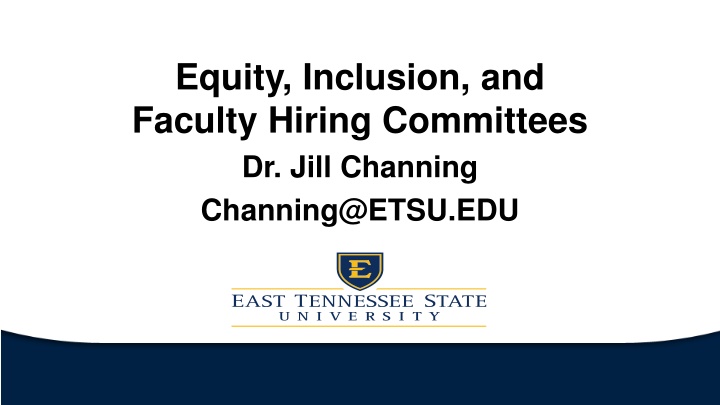
Challenges in Faculty Hiring Committees: Equity & Inclusion Issues
Navigate challenges faced by faculty hiring committees in promoting equity and inclusion, such as implicit biases, lack of diverse candidate recruitment, and issues surrounding the notion of "good fit."
Download Presentation

Please find below an Image/Link to download the presentation.
The content on the website is provided AS IS for your information and personal use only. It may not be sold, licensed, or shared on other websites without obtaining consent from the author. If you encounter any issues during the download, it is possible that the publisher has removed the file from their server.
You are allowed to download the files provided on this website for personal or commercial use, subject to the condition that they are used lawfully. All files are the property of their respective owners.
The content on the website is provided AS IS for your information and personal use only. It may not be sold, licensed, or shared on other websites without obtaining consent from the author.
E N D
Presentation Transcript
Equity, Inclusion, and Faculty Hiring Committees Dr. Jill Channing Channing@ETSU.EDU
Hiring Committees and Department Chairs Chairpersons frequently lead search committees. They often face challenges related to implicit and explicit biases. HR departments do not always have sound processes for ensuring equitable and inclusive searches. Academic departments tend to replicate themselves, and even well-meaning faculty members often inadvertently engage in search practices that do not support recruiting and hiring diverse candidates.
Challenges What are some challenges that you face ensuring equity with faculty searches?
Hiring Committee Challenges Scholars and researchers have investigated the reaffirming of Whiteness and departmental status quos during faculty search processes (Fujii, 2010; Sensoy & DiAngelo, 2017). Current laws in several U.S. states related to diversity training and legal cases involving affirmative action in higher education have created additional challenges to equitable and inclusive hiring processes.
The Problem of Good Fit What does it mean to find a good fit ? What issues do you see with this criterion?
The Problem of Good Fit What this often means for faculty from marginalized groups (King, 2022; Liera & Ching) Implicit biases often hinders access to selection processes for applicants of color and from other Historically Excluded Groups (Fujii, 2010; Sensoy & DiAngelo, 2017). Departments tend replicate themselves rather than seek those whom they would deem outsiders (Becher & Trowler, 2001; Buller, 2013).
The Problem of Good Fit White-Lewis (2020) found that fit was of less importance than search committee members idiosyncratic preferences. Idiosyncratic preferences can represent a lack of consistency in evaluating a candidate s qualifications and potentials. Committee members are challenged to define the meaning of good fit and the ways this relates to the qualifications for the position (Fujii, 2010; King, 2022).
Color- and Gender-Blindness in Faculty Search Committees Blindness occurs because committee members may not have reflected upon their own biases or have an awareness of biases (e.g. faculty members may see themselves as enlightened and rarely question these self- perceptions) Examples: Committee members question how an applicant who is a mother with young children would thrive at a research university, or they discourage applicants of color at a Predominantly White Institutions because of their fear that, if hired, the applicant would feel isolated and may not remain
Applicant Pool Why might applicant pools not be diverse?
Blaming the Applicant Pool for Lack of Faculty Diversity There are a variety of reasons for lack of diversity of applicant pools. Lack of diversity within departments (optics on department websites) Lack of diversity on search committees and with search committee chairs Limited advertising or advertisements targeting dominant populations Timing of postings
Strategies for Diversifying Applicant Pools Targeted recruiting Recruiting those not looking for jobs LinkedIn Recruiting Targeted advertising Postings that reach diverse populations Institutional and departmental web presence Partnerships with Minority Serving Institutions and organizations to create candidate pipelines
Defining Qualified What pitfalls may come with the ways search committees define qualified ?
Define Qualified Chairpersons can collaborate with search committees to examine the minimum qualifications closely and ask whether this is more than is really required. For instance, fewer years of experience could be required to attract a greater and more diverse applicant pool. Required qualifications should not change in the middle or end of a search.
Position Descriptions Careful crafting of position descriptions and postings Description of what the region has to offer diverse populations Festivals and other cultural events Descriptions of the department, campus, and community cultures Welcoming and affirming language
Search Committee Composition Sometimes diversity on a search committee is defined as one person of color, and greater diversity is needed than this. In of thinking of diverse faculty hires and search committee members, department chairpersons should think beyond racial diversity, considering ethnic, religious, intellectual, sexual orientation, and gender diversity.
Funding Considerations Chairpersons should also advocate for travel expenses to the interview to be paid and moving experiences, if hired, as having these funds available without a supplement is matter of privilege. Additional funding considerations Start-up packages Research support Professional development support
Post-Doctoral Positions Post-doctoral positions with the potential to convert into tenure-track Pipelines from Minority Serving Institutions (partnerships) Pipelines, utilizing organizations and institutional initiatives Partnership with PhD Project (Rutgers University) Partnerships with the BIPOC Project
Commitment from Senior Leadership Commitment from senior leadership positions such as deans, vice presidents, and presidents is needed. These leaders have the power and authority to implement or initiate policy changes to encourage more diverse applicant pools and to foster cultures of inclusivity. This requires more than commitment statements to diversity, but genuine efforts to recruit and retain diverse faculty members by directing funding and resources to these efforts.
Commitment from Senior Leadership Leaders must consistently communicate values related to inclusivity and equity and embed these in all institutional policies, processes, and practices. Examples: Implicit bias training for search committee members to recognize and reflect upon biases Training to contend with explicit bias such as strategies for confronting it directly when prejudicial comments or discriminatory practices become evident.
Commitment from Senior Leadership Offer flexible work arrangements to support faculty members needs Provide support for dual-career couples and families Support work-life balance and wellness for faculty and staff Offer opportunities for networking with other diverse faculty on campus (e.g. organizations for faculty of color, LGBTQ faculty, etc.) Once diverse faculty are hired, steps should be taken to retain the faculty. Welcoming environments Mentoring and support programs Professional development Career advancement opportunities Research support Competitive salaries and benefits
Case Scenario 1 You are chairing a search committee for an assistant professor position and are at the point of determining finalists. Several well-qualified candidates have been dismissed by committee members because they live outside the U.S. They believe there will be too many cultural differences for the candidates to fit in well with the department. How do you respond to this situation? Jot down a few notes.
Case Scenario 2 A department search committee has brought you a list of strengths and weaknesses for two of the four candidates interviewed for a position because they deemed two candidates unqualified. When you meet with the committee, they explain that their determination of qualified was based on qualifications developed during the search process and not on those qualifications listed in the advertisement. How do you respond to this situation? Jot down a few notes.
Case Scenario 3 A faculty member serving on an assistant/associate professor search committee comes to you with a concern about the committee. One of the search committee members has been doing independent research on all the candidates and noted from voter registrations that the majority of candidates are registered as Democrats. The committee member is demanding that the committee interview an equal number of Democrats as Republicans, as diversity of thought is important. How might you handle this situation as department leader? Jot down notes.
Your College and University Policies and Practices Discussion of policies and understanding and implementing these from the onset Problems with policies and practices Problem-solving to contend with possible institutional hiring policy inadequacies
Conclusions and Key Take-aways Think creatively about ways to attract diverse faculty (ads, recruiting, etc.). Question the idea of fit. Include only the essentials in the minimum qualifications. Carefully construct hiring committee membership and train them. Follow college or university policies and ask for clarity and HR support when needed. Think not only about recruiting but retaining faculty members.
References Becher, T., & Trowler, P. (2001). Academic tribes and territories. McGraw-Hill Education. Bilimoria, D., & Buch, K. K. (2010). The search is on: Engendering faculty diversity through more effective search and recruitment. Change: The Magazine of Higher Learning, 42(4), 27-32. Bonilla-Silva, E. (2021). Racism without racists: Color-blind racism and the persistence of racial inequality in America. Rowman & Littlefield. Buller, J. L. (2013). Positive academic leadership: How to stop putting out fires and start making a difference. John Wiley & Sons. Channing, J. (2020). What about your kids and your husband? : Gender-blind sexism in women higher education administrators narratives. Education Leadership Review, 21(1). https://www.icpel.org/ed-leadership-review.html Cross, J. D., & Carman, C. A. (2022). The relationship between faculty diversity and student success in public community colleges. Community College Journal of Research and Practice, 46(12), 855-868. Fradella, H. F. (2018). Supporting strategies for equity, diversity, and inclusion in higher education faculty hiring. In Diversity and inclusion in higher education and societal contexts (pp. 119-151). Palgrave Macmillan, Cham. Fujii, S. J. (2010). Observations, values, and beliefs about ethnic/racial diversity in community college faculty search committees. [Doctoral dissertation]. Retrieved from ProQuest Dissertations and Theses database. (ProQuest Document ID 820431300). King, A. K. (2022). Let s retire the term fit : Strategies to improve faculty heterogeneity. PS: Political Science & Politics, 19, 1-5. Liera, R., & Ching, C. (2019). Reconceptualizing merit and fit : An equity-minded approach to hiring. In Higher Education Administration for Social Justice and Equity (pp. 111-131). Routledge. White-Lewis, D. K. (2020). The facade of fit in faculty search processes. The Journal of Higher Education, 91(6), 833-857.

